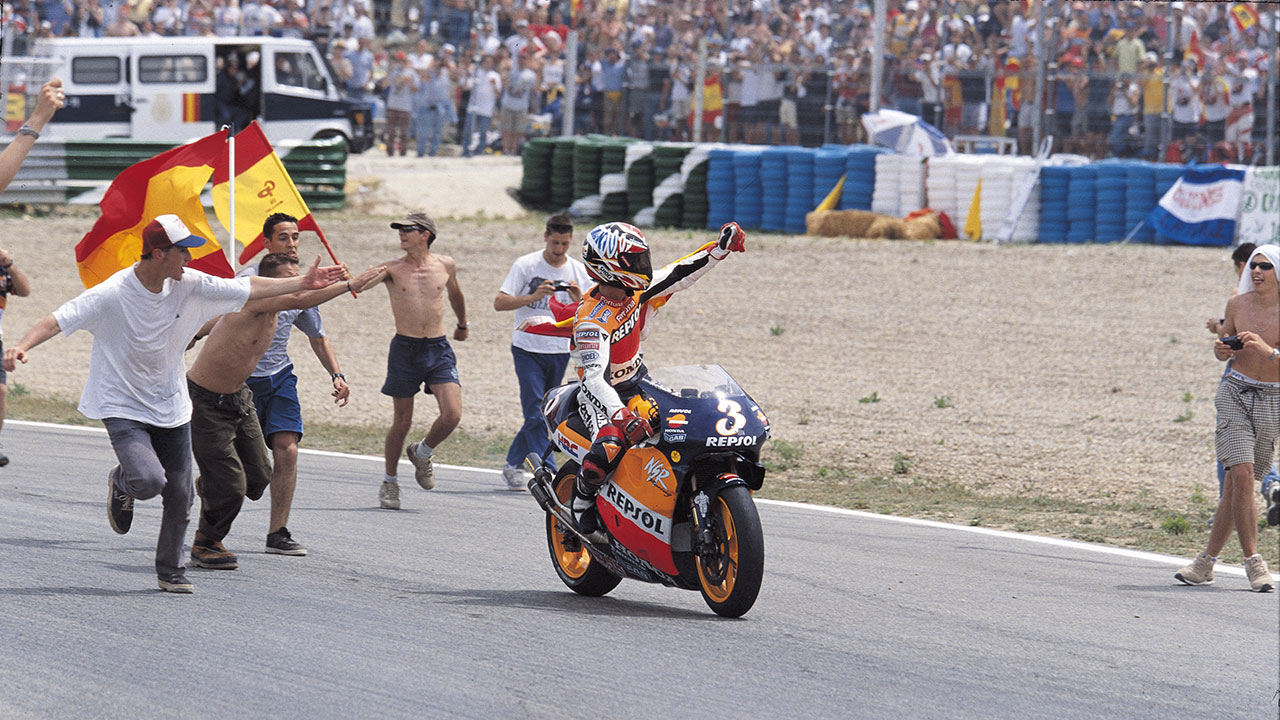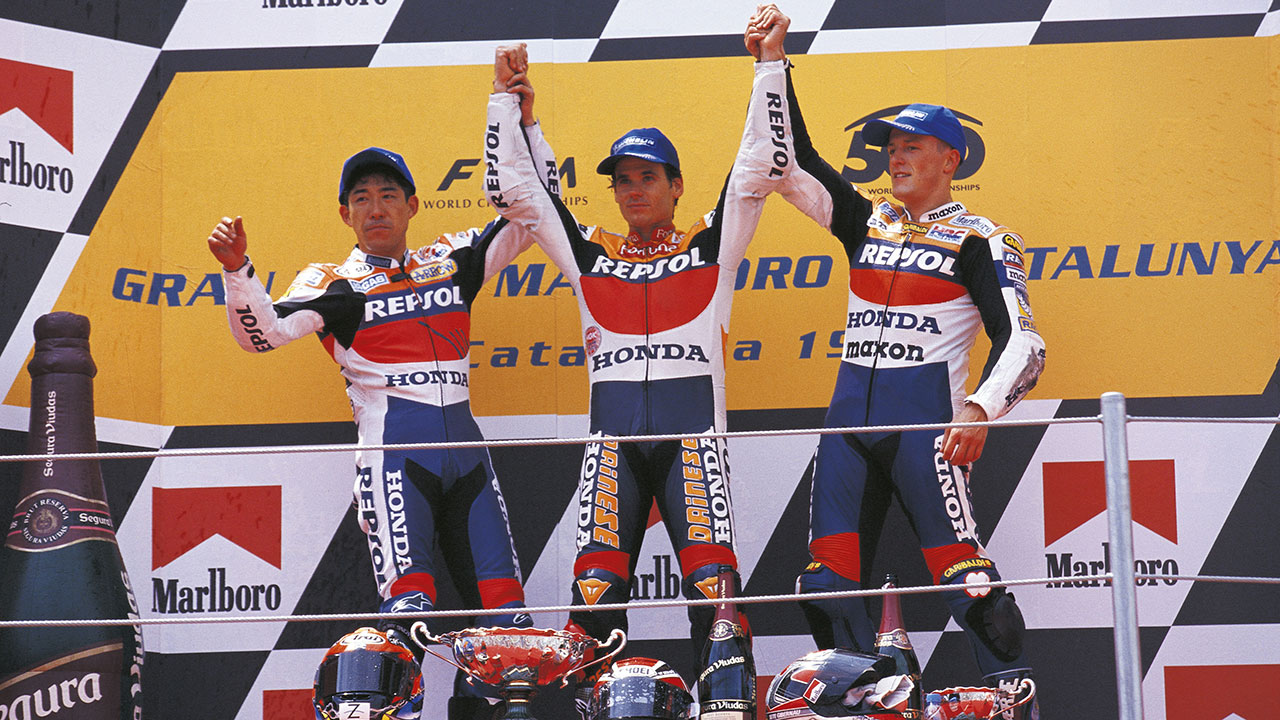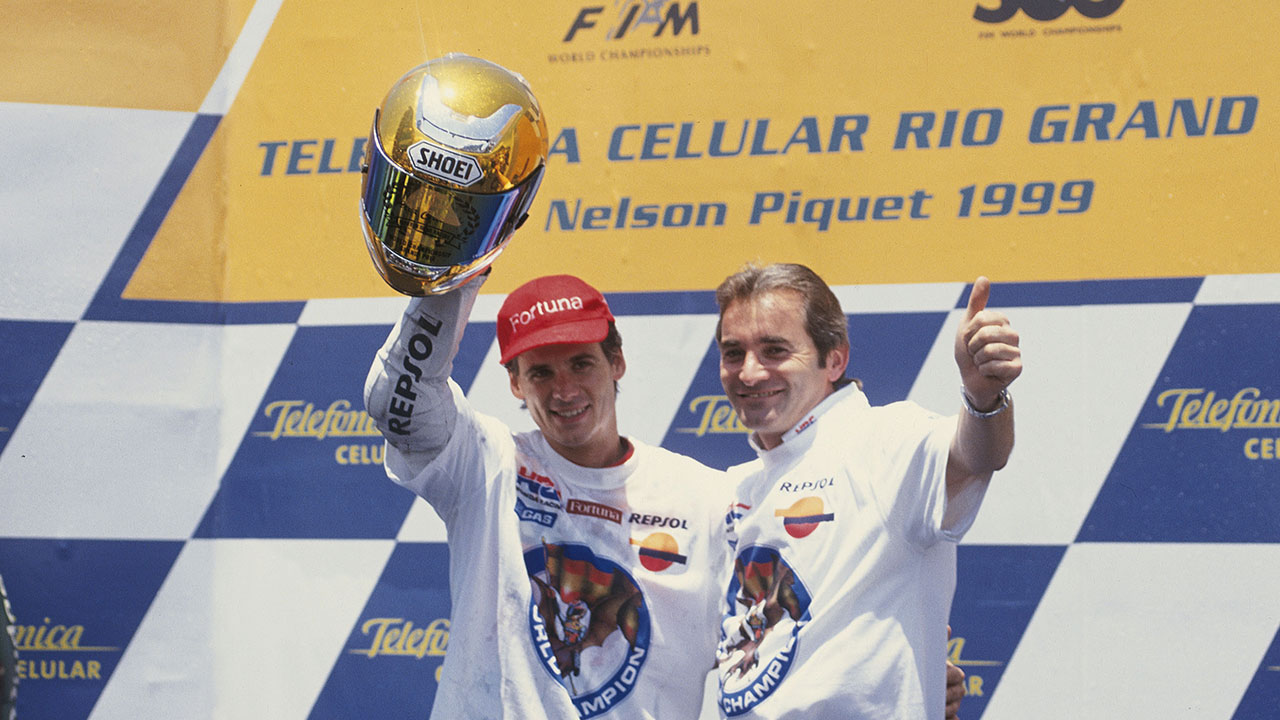The last season of the 90’s was made up of 16 races and was the year in which the Phakisa Freeway in South Africa, Motegi in Japan, Ricardo Tormo in Valencia, and Sepang in Malaysia were added for the first time. And, in that same year the Motorcycle World Championship saw the Imola in Italy, Paul Ricard in France, and the Autodromo de Buenos Aires in Argentina for the last time.
Four riders wore the Repsol Honda Team colours that season: the Australian Mick Doohan, Japanese Tadayuki Okada, and the Spaniards Sete Gibernau and Álex Crivillé, who after finishing runners-up in ’96, only needed to climb one more place to be crowned champion.
Malaysian GP:
The season started in Malaysia with the addition of the Sepang circuit and Álex Crivillé in fifth position on the grid, albeit not for very long. As soon as the light turned green, he overtook three of the four riders ahead of him and, before finishing the first lap, he had caught up on the race leader, John Kocinski. Crivillé and the North American duelled for first place, but it was to be another North American, Kenny Roberts Junior, who would take the lead in the race. This battle meant Álex ran out of spare tyres and, at the finish, and had to settle for third place. The victory went to Roberts Jr. while Doohan finished fourth and Okada in fifth.
Japanese GP:
The second race of the year saw the debut of the Motegi circuit. Owned by Honda, it promised a spectacle of braking and acceleration, but unfortunately the weather didn’t’ hold up over the weekend. A bad qualifying placed Álex Crivillé in ninth position on the starting grid, although, as in the first round of the World Championship, his good start and his ability to get back into the race led him to a commendable fourth position. His exploits left him knocking at the podium doors.
Spanish GP:
The Motorcycling World Championship came to Spain and could not have started worse. During the official training, the Repsol Honda Team rider Mick Doohan suffered a serious accident and as a result the Australian was forced out for the season. He never fully recovered and, unfortunately, he never again competed in the World Championships. A great loss for the team and for motorcycling. In that fateful Spanish Grand Prix, Álex Crivillé had the opportunity to pay tribute to his teammate by achieving pole position, the fastest lap, and a great victory that foreshadowed what was to come.


French GP:
The Paul Ricard circuit was bidding farewell as the official World Championship circuit and Álex Crivillé wanted to repeat the victory he had achieved the previous season. He returned to qualify fifth and, despite being so far back, Álex soon got himself among the podium positions. With ten laps to go at the end of the race, he was not satisfied with taking the lead of the race, he pulled away crossing the finish line with a 10-second advantage over the American John Kocinski.
Italian GP:
It was a hot GP in 1999 for Mugello both temperature wise and on the track. Álex Crivillé started from second position on the grid but lost it at the green light in favour of a recently injured Max Biaggi who started thirteenth and came back to overtake the Catalan driver. The race was a constant tit for tat between the Italian and the Spaniard, although it was the latter who came away with an Italian GP win. The difference between Álex and Max was only two tenths of a second. Third place on the podium was reserved for another Repsol Honda Team rider, Tadayuki Okada.
Catalunya GP:
The Catalunya Grand Prix is one of the fondest memories the Repsol Honda Team has of that season. In just over ten laps, Álex Crivillé ended up leading the race after starting fourth and was always closely followed by his two teammates, Tadayuki Okada and Sete Gibernau. On the fifteenth turn, Okada took first place while Crivillé slipped down to third position behind his teammate, Sete Gibernau. Spurred on by the atmosphere in the stands and the desire to achieve his fourth consecutive victory of the season, Álex began to chip away, second by second, at his teammates until catching and eventually overtaking them. The final lap, in a titanic fight with Okada, was heart-stopping, although victory this time was enjoyed by the Spanish rider by only 61 thousandths of a second. The photo of the three Repsol Honda Team riders on the Montmeló podium undoubtedly goes down in the history of motorcycling.


Dutch GP:
Álex Crivillé’s winning streak ended on the Assen circuit. After starting in fourth and trying to climb up the positions, the front end of his NSR500 lost grip on a right-hand corner on the fifth lap and Alex had to abandon the race. The bike crashed against the airfence, and Crivillé saw Okada take the victory and Sete Gibernau finished third.
British GP:
Eager to make up the points lost at the Dutch GP, Álex Crivillé qualified on the front row of the grid at Donington Park just behind poleman Okada. After a bad start, Crivillé was relegated to sixth position while the Japanese remained in the lead. As on other occasions and using all his arsenal, he started to move up the positions until reaching, on lap 11, the head of the race. Despite having the pressure of several riders on him, Álex finally achieved victory with a difference of half a second over Okada and setting the fastest lap.
German GP:
At the German GP that took place on the Sachsenring track, Álex Crivillé started in tenth position. His bad qualifying seemed it would decide the final result, but as we were used to seeing, he made a great come back and made it to second position where, from lap 14 until the end of the race, he remained in a heated battle with the Suzuki’s Kenny Roberts Jr.


Czech GP:
Brno was the scene of the tenth race of the season. Crivillé started from second place on the grid from where he fought to maintain podium positions during the first laps of the Grand Prix. At the end of the race, he took the lead, but on the last lap, Okada overtook him and managed to cross the finish line in first position. This last effort earned the Japanese rider the fastest lap of the race. The difference between the two Repsol Honda Team riders was a mere quarter of a second.
Imola GP:
At the last MotoGP held in Imola, Crivillé started first on the grid. As soon as the race kicked off, Kenny Roberts Jr., Crivillé’s biggest threat at that point in the season, kept trailing right behind the Spanish rider until he managed to overtake him. Lap after lap and with Álex y Okada ahead of him, the American rider’s motorbike lost steam and set him back a few spots. The race ended with an exciting duel with Álex Barros who finished two tenths of a second behind Seva and ahead of Biaggi who rounded off the podium. Okada came in fourth place and Roberts in sixth.
Valencian GP:
It was a historical moment at Cheste with the celebration of the first official race of the Motorcycling World Championship. The rain wanted to make an appearance at this great event and the race, even though there were dry areas, was declared wet. In these circumstances Álex Crivillé decided to go out with intermediate tyres on both wheels, while other riders opted for mixed ones for rain and the dry. This decision was decisive since a few laps from the end Álex’s rear tyre lost grip and launched the rider into the air, ending any possibility of achieving any points towards a world title.
Australian GP:
With four races to go until the season’s end and zero pints from Valencia, Álex didn’t want to risk too much at Phillip Island. Starting in twelfth position, the Spanish rider recovered a few positions and spent almost the entire race between fifth and sixth place. He ended the Australian event in a modest fifth position while teammate Okada claimed a hard-fought victory.
South African GP:
The Phakisa Freeway circuit, also called Welkom, was new to everyone on the entire grid. The first time Álex started on this track, he started from sixth position and made it up to second at the first opportunity. He kept this comfortable place until the last laps, until Sete Gibernau overtook him and relegated him to the third on the podium. The final standings for the Repsol Honda Team were Sete second, Crivillé third, and Okada fourth.
Rio GP:
And the long awaited day for Spanish motorcycling arrived. The Nelson Piquet de Río circuit was the setting where Álex Crivillé was crowned 500cc World Champion and achieved what had slipped through his fingers in previous seasons. Despite starting in eleventh position and taking the lead, Álex’s sixth position automatically made him the first Spanish Motorcycling World Champion in the top class. A milestone that opened the doors to the golden age we have today.


Argentinian GP:
The Autodromo de Buenos Aires was the Grand Prix that bid farewell to the World Championship and signed off with the historic season we had in 1999. With the title already in the bag and without any pressure, Álex Crivillé started the last grid of the season in third position. Kenny Roberts Jr., who had been one of the main rivals for the title, took control of the race from start to finish and won easily. Álex Crivillé, Repsol Honda Team rider, finished with a fifth final position to seal his great achievement.
An unforgettable rider who will forever be part of the collective memory of motorcycle lovers.


 Join Us
Join Us  Join Us
Join Us 